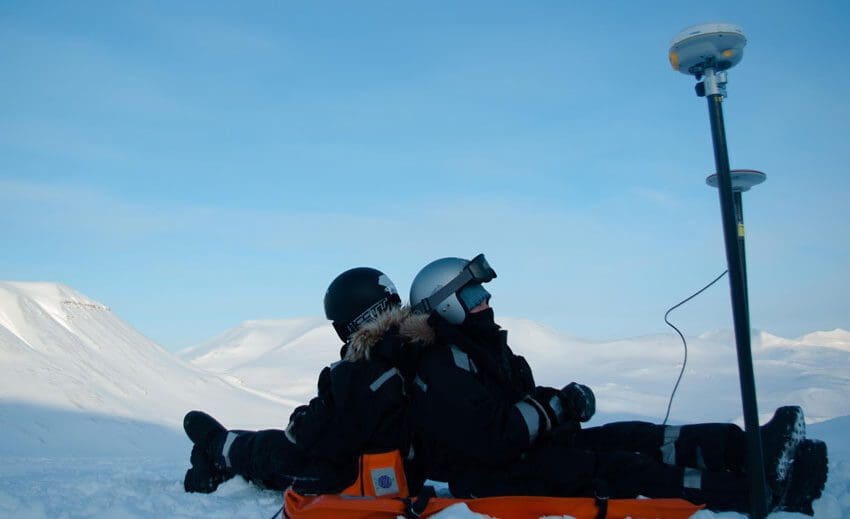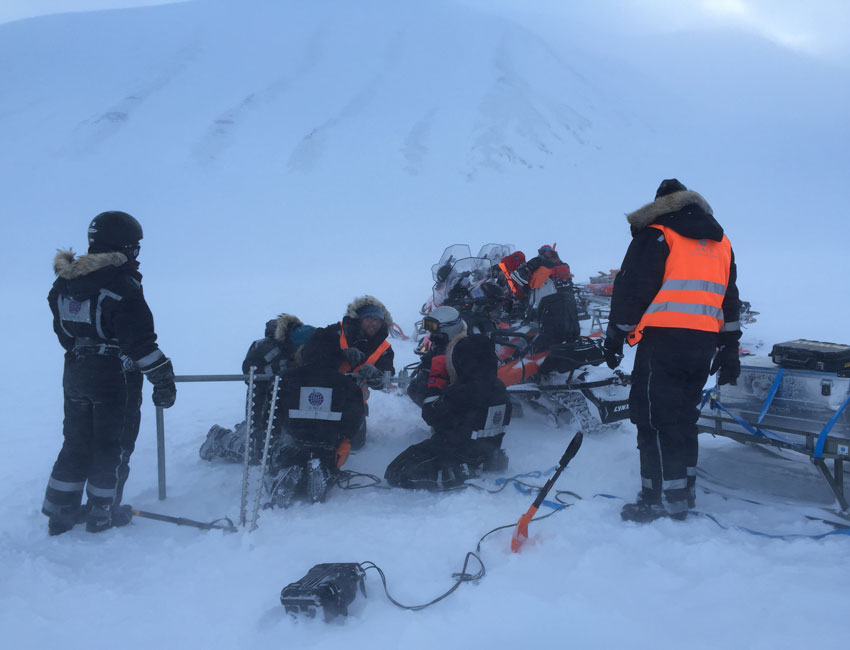AGF-212 Snow and Ice Processes (15 ECTS)
ID:
AGF-212
CREDITS:
15 ECTS
APPLICATION DEADLINE:
October 15, 2023
START DATE:
January 08, 2024
COURSE PERIOD:
Spring semester (January 8th - May 15th)

AGF-212 students taking a break during fieldwork. Photo: Johannes Pippidis Lorentzen/UNIS.
| Grade: | Letter grade (A through F) |
| Course Cost: | None |
| Course Capacity Min/Max: | 10/20 students |
| Language of instruction: | English |
| Examination support material: | Bilingual dictionary between English and mother tongue |
Course requirements
60 ECTS in mathematics and physics or a related discipline. The applicant must be enrolled in a programme at Bachelor level, or document that the courses are approved into the applicant’s current study programme.
It is also recommended that students have a minimum basic knowledge of earth science and preferably some insight into cryospheric processes. Students should have basic knowledge in thermodynamics, mechanics, and partial differential equations as well as experience of data analysis in Matlab, Python or similar tool.
The course should be combined with AGF-211 (15 ECTS), and the courses are designed to complement each other.
Academic content
AGF-212 gives an overview of the most important components and processes of the Arctic terrestrial cryosphere and its interaction with the ocean and atmosphere, with a focus on glaciers.
The course includes introductions to:
- the processes which lead to the formation of snow in the atmosphere
- the processes causing transformation of snow into ice on the ground
- the theory of mass and energy fluxes inside snow and ice masses
- the interaction of terrestrial snow and ice masses with the atmosphere and ocean
- processes of heat and mass transfer, thermal regime and the distribution of temperature inside snow, glaciers and ice sheets
- principles of glacier and ice sheet dynamics
- principles of snow and ice mechanics as it pertains to crevasses, iceberg calving, and avalanches
- modelling of the mass balance and dynamics of glaciers
- satellite remote sensing of terrestrial ice and snow.
Learning outcomes
Upon completing the course, the students will:
Knowledge
- describe observed changes to the terrestrial snow and ice in Svalbard resulting from climate change and contextualize these changes within the broader Arctic cryosphere
- examine the dominant physical processes in the Arctic snowpack relevant to snow metamorphism, snow mechanics and avalanches
- examine the processes of glacier and ice sheet formation, flow, energy balance, and feedbacks with the ocean and atmosphere.
Skills
- demonstrate field skills in snow and ice monitoring, including operation of scientific instruments and safe travel and group decision making in snow, glacier, and avalanche terrain
- integrate and analyse data collected in the field, combine it with data from other sources, and write a scientific research report.
General competences
- be able to summarize the scientific consensus and argue about the truth, implications, and importance of global changes to the cryosphere resulting from climate change.
Learning activities
The course extends over a full semester. Initially, students attend one week of compulsory Arctic survival and safety training (AS-101).
The students will initially spend about 6 weeks in the classroom covering the major topics of the course. Learning methods include readings, discussions, group activities, peer instruction, written exercises, traditional lectures, and computer lab exercises.
Once daylight has returned to the Arctic, the students will conduct fieldwork on local glaciers. Students will spend around 5 days in the field, and learn how to:
- dig a snow pit and characterise the stratigraphy of the snowpack
- conduct basic tests for assessing snow stability and avalanche conditions
- measure the distribution of snow on a glacier and the thickness of a glacier using ground penetrating radar
- measure the surface energy balance and katabatic winds on a glacier using a portable weather station
- measure the mass balance of a glacier using ablation stakes and cables
- measure glacier flow velocity and ice flux by measuring the position of stakes using a differential GPS system
Following the fieldwork, students will analyse the collected data and write a comprehensive research report.
Summary
- Total lecture hours: Ca. 45 hours.
- Total seminar hours: Ca. 15 hours.
- Total exercises hours: Ca. 20 hours.
- Fieldwork: Ca. 5 days.
Compulsory learning activities
All compulsory learning activities must be approved in order to sit the exam.
- Fieldwork
- Oral presentation of field report
Assessment
All assessments must be passed in order to pass the course.
Each assessment is graded, and subsequently combined into a single grade. Partial grades for each assessment will be available.
| Method | Duration |
Percentage of final grade
|
| Written fieldwork report | 50 % | |
| Written exam | 3 hours | 50 % |
Student life

